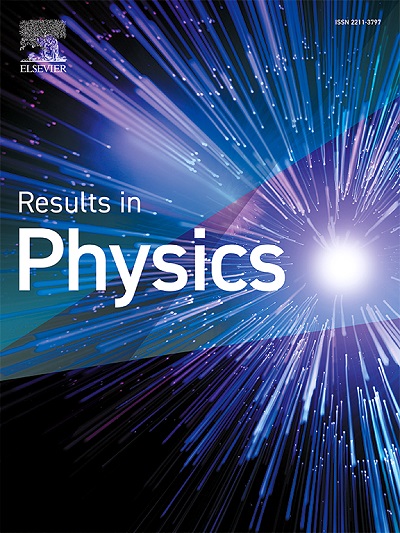Physical, structural, optical and thermal investigations of TeO2-modified borate glass for solid-state devices
IF 4.4
2区 物理与天体物理
Q2 MATERIALS SCIENCE, MULTIDISCIPLINARY
引用次数: 0
Abstract
The impact of varying TeO2 content (0, 10, and 20 mol%) on the physical, optical, structural, and thermal properties was investigated for Eu2O3 doped borate glasses. Physical parameters such as sample density, molar volume, and ion concentration confirm the structural changes resulting from TeO2 doping. The optical band gap, calculated from absorption spectra using Tauc’s plot, indicates the presence of localized states between the valence and conduction bands. X-ray diffraction (XRD) analyses confirm that the samples exhibit glass characteristics. FTIR studies demonstrate effective Te-O-Te linkages. The thermal properties, were assessed using differential thermal analysis (DTA), differential scanning calorimetry (DSC), and thermogravimetric analysis (TGA). The DSC analysis revealed a computed △T of approximately 200 °C, indicating good thermal stability for the CNEBT glass. The crystallization onset and peak crystallization temperatures were observed to increase with the addition of TeO2. The reduced glass transition temperature (Trg) values suggest that internal crystallization is suppressed. TGA analysis confirmed weight loss attributed to the release of trapped solvents. The findings suggest that these glasses are suitable for use in high-temperature solid-state devices.
用于固态设备的 TeO2 改性硼酸盐玻璃的物理、结构、光学和热学研究
研究了不同TeO2含量(0、10和20 mol%)对Eu2O3掺杂硼酸盐玻璃的物理、光学、结构和热性能的影响。样品密度、摩尔体积和离子浓度等物理参数证实了TeO2掺杂导致的结构变化。利用Tauc图计算吸收光谱的光学带隙,表明价带和导带之间存在局域态。x射线衍射(XRD)分析证实样品具有玻璃化特征。FTIR研究证实了有效的Te-O-Te联系。热性能通过差热分析(DTA)、差热扫描量热法(DSC)和热重分析(TGA)进行评估。DSC分析显示计算的△T约为200°C,表明CNEBT玻璃具有良好的热稳定性。结晶起始温度和结晶峰温度随TeO2的加入而升高。玻璃化转变温度(Trg)值的降低表明内部结晶受到抑制。TGA分析证实重量减轻归因于被困溶剂的释放。研究结果表明,这些玻璃适合用于高温固态器件。
本文章由计算机程序翻译,如有差异,请以英文原文为准。
求助全文
约1分钟内获得全文
求助全文
来源期刊

Results in Physics
MATERIALS SCIENCE, MULTIDISCIPLINARYPHYSIC-PHYSICS, MULTIDISCIPLINARY
CiteScore
8.70
自引率
9.40%
发文量
754
审稿时长
50 days
期刊介绍:
Results in Physics is an open access journal offering authors the opportunity to publish in all fundamental and interdisciplinary areas of physics, materials science, and applied physics. Papers of a theoretical, computational, and experimental nature are all welcome. Results in Physics accepts papers that are scientifically sound, technically correct and provide valuable new knowledge to the physics community. Topics such as three-dimensional flow and magnetohydrodynamics are not within the scope of Results in Physics.
Results in Physics welcomes three types of papers:
1. Full research papers
2. Microarticles: very short papers, no longer than two pages. They may consist of a single, but well-described piece of information, such as:
- Data and/or a plot plus a description
- Description of a new method or instrumentation
- Negative results
- Concept or design study
3. Letters to the Editor: Letters discussing a recent article published in Results in Physics are welcome. These are objective, constructive, or educational critiques of papers published in Results in Physics. Accepted letters will be sent to the author of the original paper for a response. Each letter and response is published together. Letters should be received within 8 weeks of the article''s publication. They should not exceed 750 words of text and 10 references.
 求助内容:
求助内容: 应助结果提醒方式:
应助结果提醒方式:


